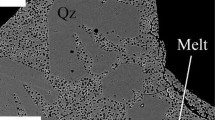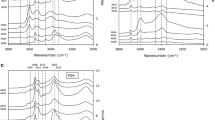Abstract
Thirty spodumene samples of distinct paragenetic types (primary magmatic, secondary after petalite and hydrothermal) from variety of granitic pegmatites were characterized by electron microprobe, polarized FTIR spectroscopy and Mössbauer spectroscopy. The FTIR spectra of OH (weak sharp pleochroic bands at 3,425, 3,410, 3,395 cm−1 and in the 3,500–3,470 spectral region) are strongly polarized with maximum absorption parallel to nγ. The majority of OH dipoles are presumably generated by a partial replacement of O2 oxygen atoms with an orientation pointing above the Li vacancy site. The separation of the bands probably resulted from a replacement of the coordinating Al by Fe and Si by Al. Homogeneous spodumene mostly close to its ideal formula LiAlSi2O6 shows Fe (0.00–0.10 apfu as Fe3+; Fe3+ >> Fe2+) and Na (0.00–0.04 apfu) as the only minor cations and Fe3+Al−1 substitution up to 10 mol% of the LiFe3+Si2O6 component. Hydrogen concentrations (from 0.1 up to <5 ppm H2O by weight) vary as a function of genetic type with the highest amounts in high-temperature magmatic spodumene. Differences among particular genetic types of spodumene are related to maximum solubility of OH in spodumene structure at given P–T conditions and at actual chemical composition of spodumene. OH defect concentrations in spodumene follow a trend, LT/LP pyroxenes containing lower hydrogen contents compared to HT/HP ones. The hydrogen contents in particular genetic types of spodumene and their decrease with decreasing T and P are consistent with petrologic models of the pegmatite (sub)types formations.






Similar content being viewed by others
References
Andrut M, Brandstatter F, Beran A (2003) Trace hydrogen zoning in diopside. Miner Petrol 78:231–241
Arredondo EH, Rossman GR, Lumpkin GR (2001) Hydrogen in spessartine–almandine garnets as a tracer of granitic pegmatite evolution. Am Mineral 86:485–490
Bai Q, Kohlstedt DL (1993) Effects of chemical environment on the solubility and incorporation mechanism for hydrogen in olivine. Phys Chem Miner 19:460–471
Bell DR, Rossman GR (1992) Water in Earth’s mantle: the role of nominally anhydrous minerals. Science 255:1391–1397
Bell DR, Ihinger PD, Rossman GR (1995) Quantitative analysis of trace OH in garnet and pyroxenes. Am Mineral 80:465–474
Bell DR, Rossman GR, Maldener J, Endisch D, Rauch F (2004) Hydroxide in kyanite: a quantitative determination of the absolute amount and calibration of the IR spectrum. Am Mineral 89:998–1003
Beran A (1999) Contribution of IR spectroscopy to the problem of water in the Earth’s mantle. In: Wrigt K, Catlow R (eds) Microscopic properties and processes in minerals. Kluwer, Holland, pp 523–538
Beran A (2002) Infrared spectroscopy of micas. In: Mottana A et al (eds) Micas: crystal chemistry and metamorphic petrology. Rev Miner Geochem 46:351–369
Beran A, Libowitzky E (2003) IR spectroscopic characterization of OH defects in mineral phases. Phase Transit 76:1–15
Beran A, Langer K, Andrut M (1993) Single crystal infrared spectra in the range of OH fundamentals of paragenetic garnet, omphacite and kyanite in an eklogitic mantle xenolith. Miner Petrol 48:257–268
Bromiley GD, Keppler H, McCammon C, Bromiley FA, Jacobsen SD (2004) Hydrogen solubility and speciation in natural, gem-quality chromian diopside. Am Mineral 89:941–949
Černý P (1982a) Anatomy and classification of granitic pegmatites. In: Černý P (ed) Granitic pegmatites in science and industry. Short course handbook 8. Mineralogical Association of Canada, pp 1–39
Černý P (1982b) Petrogenesis of granitic pegmatites. In: Černý P (ed) Granitic pegmatites in science and industry. Short course handbook 8. Mineralogical Association of Canada, pp 405–461
Černý P (1991) Rare-element granitic pegmatites. I. Anatomy and internal evolution of pegmatite deposits. Geosci Can 18:49–67
Černý P (2004) The Tanco rare-element pegmatite deposit, Manitoba: regional context, internal anatomy, and global comparisons. In: Linnen RL, Samson IM (eds) Rare-element geochemistry and ore deposits. Short course handbook 17. Geological Association of Canada, pp 184–231
Černý P, Ercit TS (2005) Classification of granitic pegmatites. Can Mineral (in press)
Černý P, Trueman DL, Ziehlke DV, Goad BE, Paul BJ (1981) The Cat Lake–Winnipeg River and the Wekusko Lake pegmatite fields, Manitoba. Manitoba energy & mines. Econ Geol Rep ER80-1, pp 1–234
Chakoumakos BC, Lumpkin GR (1990) Pressure–temperature constraints on the crystallization of the Harding pegmatite, Taos County, New Mexico. Can Mineral 28:287–298
Charoy B, Lhote F, Dusausoy Y (1992) The crystal chemistry of spodumene in some granitic aplite-pegmatites of northern Portugal. Can Mineral 30:639–651
Charoy B, Noronha F, Lima A (2001) Spodumene–petalite–eucryptite: mutual relationships and pattern of alteration in Li-rich aplite-pegmatite dykes from northern Portugal. Can Mineral 39:729–746
Clark JR, Appleman DE, Papike JJ (1969) Crystal-chemical characterization of clinopyroxenes based on eight new structure refinements. Special paper 2. Mineralogical Society of America, pp 31–50
Deer WA, Howie RA, Zussman J (1997) Rock-forming minerals, 2nd edn. Single-chain silicates, vol 2A. Geological Society, London, pp 1–668
De Grave E, Eeckhout SG (2003) 57Fe Mössbauer-effect studies of Ca-rich, Fe-bearing clinopyroxenes: Part III. Diopside. Am Mineral 88:1145–1152
Dollase WA, Gustafson WI (1982) 57Fe Mössbauer spectral analysis of the sodic clinopyroxenes. Am Mineral 67:311–327
Doria A, Charoy B, Noronha F (1989) Fluid inclusion studies in spodumene-bearing aplite-pegmatite dykes of Covas de Barroso, Northern Portugal. In: ECROFI X, London, p 25
Farmer VC (1974) The infrared spectra of minerals. Monograph No. 4. Mineralogical Society, London, pp 1–539
Foord EE, Starkey HC, Taggert JE Jr (1986) Mineralogy and paragenesis of “pocket” clays and associated minerals in complex granitic pegmatites, San Diego County, California. Am Mineral 71:428–439
Foord EE, London D, Kampf AR, Shigley JE, Snee LW (1991) Gem-bearing pegmatites of San Diego County, California. In: Walamender MJ, Hanan BB (eds) Geological excursions in Southern California and Mexico. Field Trip Guidebook for the 1991 Annual Meeting. Geological Society America, San Diego, pp 128–146
Göd R (1989) The spodumene deposit at “Weinebene”, Koralalpe, Austria. Miner Deposita 24:270–278
Graham J (1975) Some notes on α–spodumene, LiAlSi2O6. Am Mineral 60:919–923
Ingrin J, Skogby H (2000) Hydrogen in nominally anhydrous upper-mantle minerals: concentrations levels and implications. Eur J Mineral 12:543–570
Ingrin J, Hercule S, Charton T (1995) Diffusion of hydrogen in diopside—results of dehydration experiments. J Geophys Res 100(B8):15489–15499
Kazmi AH, Peters JJ, Obodda HP (1985) Gem pegmatites of the Shingus-Dusso Area, Gilgit, Pakistan. Mineral Rec 16:393–411
Keppler H, Rauch M (2000) Water solubility in nominally anhydrous minerals measured by FTIR and 1H MAS NMR: the effect of sample preparation. Phys Chem Miner 27:371–376
Koch-Müller M, Matsyuk SS, Wirth R (2004) Hydroxyl in omphacites and omphacitic clinopyroxenes of upper mantle to lower crustal origin beneath the Siberian platform. Am Mineral 89:921–931
Kohlstedt DL, Mackwell SJ (1999) Solubility and diffusion of “water” in silicate minerals. In: Wrigt K, Catlow R (eds) Microscopic properties and processes in minerals. Kluwer, Holland, pp 539–559
Krivovichev VG (2004) Mineral equilibria with spodumene, petalite and eucryptite. I. System Li2O–Al2O3–SiO2–H2O—thermodynamical analysis and geological application. Proc Russ Mineral Soc 133:1
Kunasz I (1982) Foote Mineral Company—Kings mountain operation. In: Černý P (ed) Granitic pegmatites in science and industry. Short course handbook 8. Mineralogical Association of Canada, pp 505–511
Libowitzky E (1999) Correlation of O–H stretching frequencies and O–H···O hydrogen bond lengths in minerals. Monatsh Chem 130:1047–1059
Libowitzky E, Beran A (2004) IR spectroscopic characterization of hydrous species in minerals. In: Beran A, Libowitzky E (eds) EMU notes in mineralogy 6. Eötvös Univ Press, Budapest, pp 227–279
Libowitzky E, Rossman GR (1996) Principles of quantitative absorbance measurements in anisotropic crystals. Phys Chem Miner 23:319–327
Libowitzky E, Rossman GR (1997) An IR absorption calibration for water in minerals. Am Mineral 82:1111–1115
London D (1984) Experimental phase equilibria in the system LiAlSiO4–SiO2–H2O: a petrogenetic grid for lithium-rich pegmatites. Am Mineral 69:995–1004
London D (1986a) Magmatic-hydrothermal transition in the Tanco rare-element pegmatite: evidence from fluid inclusions and phase equilibrium experiments. Am Mineral 71:376–395
London D (1986b) Formation of tourmaline-rich gem pockets in miarolitic pegmatites. Am Mineral 71:396–405
London D (2004) Geochemistry of alkali and alkaline earth elements in ore-forming granites, pegmatites and rhyolites. In: Linnen RL, Samson IM (eds) Rare-element geochemistry and ore deposits. Short course notes 17, Geological Association of Canada, pp 25–69
London D, Burt DM (1982) Lithium minerals in pegmatites. In: Černý P (ed) Granitic pegmatites in science and industry. Short course handbook 8. Mineralogical Association of Canada, pp 99–133
Losos Z, Beran A (2004) OH defects in cassiterite. Miner Petrol 81:219–234
Lumpkin GR (1998) Rare-element mineralogy and internal evolution of the Rutherford no. 2 pegmatite, Amelia County, Virginia: a classic locality revisited. Can Mineral 36:339–353
Makrygina VA, Makagon VM, Zagorsky VE, Shmakin BM (1990) Mica-bearing pegmatites (in Russian). Nauka, Siberia, pp 1–233
Merlet C (1994) An accurate computer correction program for quantitative electron probe microanalysis. Mikrochim Acta 114/115:363–376
Mulja T, Williams-Jones AE, Wood SA, Boily M (1995) The rare-element-enriched monzogranite–pegmatite–quartz vein systems in the Preissac–Lacorne batholith, Quebec. II. Geochemistry and petrogenesis. Can Mineral 33:817–822
Paterson MS (1982) The determination of hydroxyl by infrared absorption in quartz, silicate glasses and similar materials. Bull Mineral 105:20–29
Rossman GR (1996) Studies of OH in nominally anhydrous minerals. Phys Chem Miner 23:299–304
Skogby H (1999) Water in nominally anhydrous minerals. In: Wright K, Catlow R (eds) Microscopic properties and processes in minerals. Kluwer, Holland, pp 509–522
Skogby H, Rossman GR (1989) OH− in pyroxene: an experimental study of incorporation mechanisms and stability. Am Mineral 74:1059–1069
Skogby H, Bell DR, Rossman GR (1990) Hydroxide in pyroxene: variations in the natural environment. Am Mineral 75:764–774
Smeds SA, Černý P (1989) Pollucite from the Proterozoic petalite-bearing pegmatites of Uto, Stockholm archipelago, Sweden. Geol Förenin Stockholm Förh 111:361–372
Spear FS (1993) Metamorphic phase equilibria and pressure–temperature–time paths. Mineralogical Society of America Monograph, Washington, pp 1–799
Stalder R (2004) Influence of Fe, Cr and Al on hydrogen incorporation in orthopyroxene. Eur J Mineral 16:703–711
Taylor BE, Foord EE, Friedrichsen B (1979) Stable isotope and fluid-inclusion studies of gem-bearing granitic pegmatite-aplite dikes, San Diego Co., California. Contrib Mineral Petrol 68:187–205
Thomas AV, Pasteris JD, Bray CJ, Spooner ETC (1990) H2O–CH4–NaCl–CO2 inclusions from the footwall contact of the Tanco granitic pegmatite: estimates of internal pressure and composition from microthermometry, laser Raman spectroscopy, and gas chromatography. Geochim Cosmochim Acta 54:539–573
Veblen DR, Buseck PR (1981) Hydrous pyriboles and sheet silicates in pyroxenes and uralites: intergrown microstructures and reaction mechanisms. Am Mineral 66:1107–1134
Walker RJ, Hanson GN, Papike JJ, O´Neil JR, Laul JC (1986) Internal evolution of the Tin Mountain pegmatite, Black Hills, South Dakota. Am Mineral 71:440–459
Acknowledgement
This work has been supported by a Marie Curie Fellowship of the European Commission under contract number HPMT-CT-2000-00138 to JF and by research projects of Ministry of Education of Czech Republic (MSM0021622412 to MN and MSM6198959218 to RZ). Major part of this work has been done during stay of JF at the University of Vienna. We wish to thank A. Wagner for his delicate sample preparation, U. Kolitsch, A. Wieczorek, J. Leichmann, R. Škoda and M. Mashlan for technical assistance. Samples for this study were kindly provided by the Moravian Museum in Brno, Czech Republic, E. Libowitzky and M. Bohatý.
Author information
Authors and Affiliations
Corresponding author
Rights and permissions
About this article
Cite this article
Filip, J., Novák, M., Beran, A. et al. Crystal chemistry and OH defect concentrations in spodumene from different granitic pegmatites. Phys Chem Minerals 32, 733–746 (2006). https://doi.org/10.1007/s00269-005-0051-0
Received:
Accepted:
Published:
Issue Date:
DOI: https://doi.org/10.1007/s00269-005-0051-0




